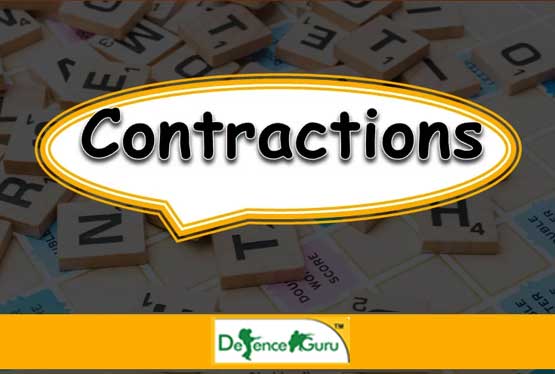Contractions
Short forms make our communication more productive and fascinating. It is important for us to be updated with contractions in English Language. There are important facts to kept in mind while framing a contraction (combining two words into one).
Forms of contractions
There are two categories in the contractions.
- 1. Subject + auxiliary verb
- 2. Auxiliary verb + not
Subject + auxiliary verb
It is necessary to know the auxiliary verbs before getting them contracted with other words.
- 1. To be- is, am, are, was, were
- 2. To do- do, does, did
- 3. To have- has, have, had, will have, shall have
- 4. Modal Auxiliaries- will, would, shall, should, can, could, may, might, must
The contraction of subject+ Auxiliary is made by dropping the beginning of the auxiliary verb. The dropped section is shown by an apostrophe comma. Here students are advised to pay attention at the dropped segment as it creates confusion. Place of apostrophe comma is also an attentive part.
Examples
|
I am => I’m |
I have => I’ve |
|
I will/shall => I’ll |
I would, should => I’d |
|
I had => I’d |
You are => You’re |
|
You have => You’ve |
It is, has => It’s (*) |
Note (*): “Arun is” can be written Arun’s but this contraction has confusion of Arun’s father. Here it is advised to follow apostrophe comma for the sense “of”. Similarly “Arun has a lot of information” can be written as “Arun’s a lot of information” but the point of confusion shouldn’t be there.
Auxiliary Verb + not
This contraction drops ‘o’ letter and it is replaced by apostrophe comma ‘
|
Does not => doesn’t |
Do not => don’t |
|
Is not => isn’t |
Was not => wasn’t |
|
Am not => aren’t (*) |
Were not => weren’t |
|
Are not => aren’t |
Has not => hasn’t |
|
Had not => hadn’t |
Have not => haven’t |
|
Will not => won’t |
Shall not => Shan’t |
|
Did not => didn’t, dint |
|
Note: The above given negative contractions of auxiliary verbs can be used in sentences. Other than this, one more method of formation can be evolved.
He’s not there. He isn’t there.
They’ll not come today. They won’t come today.
Contraction of Modal Verbs
|
Cannot => can’t |
Could not => couldn’t |
|
May not => mayn’t |
Might not => mightn’t |
|
Shall not => Shan’t |
Should not => shouldn’t |
|
Will not => won’t |
Would not => wouldn’t |
|
Dare not => daren’t |
Need not => needn’t |
|
Ought not => oughtn’t |
Must not => mustn’t |
|
Here is => here’s |
How is => How’s |
|
There is => there’s |
What is => what’s |
|
That is => that’s |
Who is => who’s |
|
That will => that’ll |
What will => what’ll |
|
They were => they’re |
Who will => who’ll |
|
They are => they’re |
Who would => who’d |





















